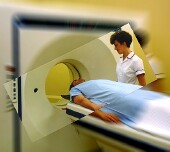
MONDAY, Sept. 27 (HealthDay News) — Medical imaging procedures conducted as part of clinical trials accidentally detect tumors, aneurysms or infections in nearly 40 percent of participants, but in many cases the health impact of these “incidental findings” is unclear, a new study finds.
Researchers analyzed the medical records of 1,426 people who underwent an imaging procedure related to a study conducted in 2004 and found that suspicious incidental findings occurred in 39.8 percent of the patients.
The likelihood of an incidental finding increased with age, and the highest rates were among patients undergoing CT scans of the abdomen and pelvic area, CT scans of the chest, and MRIs of the head.
Clinical action was taken for 6.2 percent of the patients in which imaging turned up tumors or infections unrelated to the clinical trial. In 4.6 percent of the cases, the medical benefit or risk was unclear. “Clear medical benefit” was seen in six patients, and “clear medical burden” — generally characterized by harm, unnecessary treatment and/or the excess cost of investigating suspicious findings — was seen in three patients, the researchers found.
The findings appear online Sept. 27 in the journal Archives of Internal Medicine.
“This study demonstrates that research imaging incidental findings are common in certain types of imaging examinations, potentially offering an early opportunity to diagnose asymptomatic life-threatening disease, as well as a potential invitation to invasive, costly and ultimately unnecessary interventions for benign processes,” wrote Dr. Nicholas M. Orme, of the Mayo Clinic in Rochester, Minn.
Because the significance of most cases is unclear, they said, “these instances represent a dilemma for researchers.”
What is needed is a plan to deal with suspicious findings, the researchers said.
“Timely, routine evaluation of research images by radiologists can result in identification of incidental findings in a substantial number of cases that can result in significant medical benefit to a small number of patients,” they concluded.
More information
The U.S. National Institutes of Health has more about diagnostic imaging.

